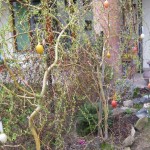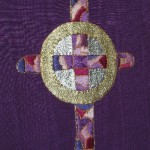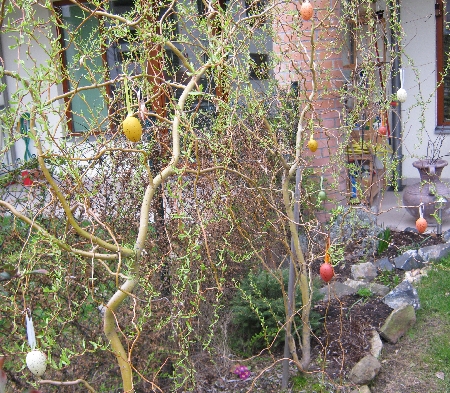
Despite my good intentions, I’ve once more been very slow in writing the promised post about my first Holy Week and Easter in the Czech Republic. Although we are still in the Easter season I’m all too aware that my comments will be somewhat dated if I don’t write a blog post soon.
As in the UK, one has to distinguish between the way Easter is marked in the predominantly secular commercial world, as against the way it is celebrated in the Christian Churches. One initial observation is that the commercial world does not start displaying its Easter goodies as early as it does in Britain. In Britain, I have many times cringed seeing hot-cross buns and Easter Eggs on sale before even the Feast of the Epiphany on 6th January has passed. Here in Prague, Lent had at least begun before any Easter goods were on display.
However, the so-called Easter goods seen in Prague supermarkets seemed to me to bear very little relation to Gospel accounts of the death and resurrection of Jesus Christ. Various floral decorations, artificial and real, together with rabbits of every shape and description, mostly made of chocolate, filled the shelves. Other than vaguely representing new life, I could see very little relevance to the greatest festival of the Christian year. The Easter Bunny was what mattered, not the risen Christ.
Unlike in the UK, many people decorate their houses, flats and gardens for Easter. The Czechs love to paint and decorate eggs, then tie them with ribbons to trees in their gardens or attach them to sticks stuck into window boxes of their flats and shops. Similar traditions can also be found in Germany, Austria and Switzerland. However, one peculiar Czech tradition is also to place such decorations on family graves which Sybille told me she had never seen whilst she lived in Germany.
With regard to Church tradition and practice, one thing I soon discovered was that distributing palm crosses on Palm Sunday is something peculiarly Anglican! Not initially realising this, I made enquiries about purchasing palm crosses at a Roman Catholic shop that sells books and Church supplies and from where we obtain our communion wafers. My request was met with a look of complete bewilderment, even when a helpful customer translated my English into Czech. I rapidly emailed the English company I had previously dealt with when in Oxfordshire, who were happy to oblige.
Another difference between the UK and the Czech Republic is that Good Friday is not a public holiday here. Therefore, it is not really worthwhile to try and hold a service beginning at 2pm to mark the last hour of the cross, as most people have to be at work. Instead, I conducted a devotional service of Bible readings, prayers and times of silence for reflection, starting at 7.30pm in the evening.
Whilst the Good Friday service and our Eucharist on Maundy Thursday evening were reasonably well attended, as was my experience in Britain, many more people turned out on Easter Day. Yet for me, celebrating the joy of the resurrection on Easter Day is so much more meaningful if I have first sought to enter into and tried to understand the sense of betrayal and the depth of suffering that Jesus experienced on the first Maundy Thursday and Good Friday.
Easter Day saw my largest congregation since arriving in Prague in September 2008. We had approximately 110 adults and a dozen children and I had to consecrate additional bread and wine to communicate all those who wished to make their Easter communion. About half were regular members of the congregation bearing in mind that quite a number of our regulars go ‘home’ for the Easter break. The other half were mainly visitors, enjoying a long weekend in Prague, together with some ex-pat ‘festival worshippers’ whom we last saw at the Carol Service in December! We ended our worship with a rousing rendition of ‘Thine be the glory’ to the wonderful tune by Handel called ‘Maccabaeus’.
Alleluia, Christ is risen! He is risen indeed. Alleluia!




Hi Ricky,
I see you are still getting used to foreign ways – No Good Friday took some getting used to from my end.
This hopefully will not be your last Holy Week there. I have found that the non-commmercial Easter celebration from this side of Europe is very much uplifting for the soul for everyone.
Take Care
Hi Ricky,
I enjoyed your post about Holy Week…it is very different here, compared to back home, in the US. One of the symbols that I’ve come to love are the kraslice–the decorated eggs. Some of the designs are so intricate…I’ve seen some that were truly very Easter.
Anyway, my husband and I very much enjoyed the Maundy Thursday service we were able to attend at the church…lovely service, really.
Have a great day!
Sher :0)
Hello Ricky, I was tickled with the story of the palm cross. I do that so often, asking for something only to realize it just doesn’t exist here in Italy.
Do you have your services in English or translated into Czech? Somehow I imagine it is for the English speaking community because Czech is not an easy language to pick up in, what…8 months.
We celebrated Easter the weekend of April 10 through 13, then I heard that in Belarus, they were celebrating it the week after. Not sure if that info is correct but my friend was under that impression when he was visiting. Which weekend did you celebrate in Prague?
Bev
How nice to have three genuine comments amongst all the spam that my blog seems to attract!
Martin – Yes I do plan to be here for 7 or 8 more Holy Weeks. And also seeing Easter marked less commercially is refreshing.
Sher – I agree with you, many of the decorated eggs are very beautiful, hence I posted a picture of them on my blog! Like you, I’ve seen some decorated with a cross or an empty tomb thus portraying the true meaning of Easter. It was lovely to see you both at Church on Maundy Thursday.
Bev – I guess it won’t be the last time either that I ask for something I think everyone knows about only to discover it is peculiarly British and unknown in the Czech Republic!
To answer your other questions. I conduct services in English for the English-speaking community here in Prague. Some Czech people do attend because they are married to English-speakers, they like our liturgy or they want to improve their English. You’re right, Czech is NOT an easy language to learn. I’m off to my twice weekly language class shortly.
We celebrated Easter on exactly the same dates as you did in Italy because, like the Roman Catholic Church, we follow the Gregorian calendar. It is only the Orthodox Churches, who still follow the Julian calendar, who celebrate Easter on a different date which this year was one week later. The majority Church in Belarus is the Orthodox Church therefore your friend was quite correct with his impression. This Wikipedia article http://en.wikipedia.org/wiki/Julian_calendar explains more.
Extremely interesting information Ricky. Thank you. (I think everybody, especially young people should travel because I find I am interested in things that would have never made me blink before. I had no idea that there were two calendars…never paid attention because obviously these have been around pretty much forever!)
Thanks for the link
Bev